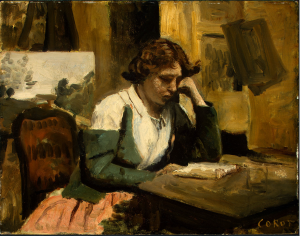
Young Girl Reading by Jean-Baptiste-Camille Corot is, I think, a beautiful example of a Realist painting from the 1800s.
Until the end of the 19th century the term Realism meant observing the world in its natural form. It was a representation of the external world as it was actually seen and experienced.
The Realists were responding to the political and social upheaval in Europe in the early part of the century. They rejected what they perceived to be the artificiality of both Classicism and Romanticism. Instead they presented a non-escapist, democratic and empirical view of life as it existed around them, far removed from the heroic and idealised paintings such as Liberty Leading the People by Eugéne Delacroix.
They painted ordinary people leading their everyday lives, conscientiously reproducing what had been largely ignored aspects of contemporary life and society. In particular they focused on the physical settings, material circumstance and living conditions of the middle and lower classes, which until this time were not seen as worthy subjects for academic art. Landscapes were also popular subjects.
The natural world was seen as a place of worship by poets and artists alike. However, realist pictures of working men and women going about their business could be distinctly ordinary. Many viewers criticised such pictures as lacking in poetry and imagination, while other critics applauded them as having a more democratic form of art in keeping with the times.
Although realistic paintings were not characterised by a single style, they were often infused with a robustness and energy conveyed through bold lines, strong tonal contrasts, broad handling of paint and a sombre palette.
Jean-Louis-Ernest Meissonier, for example, was interested in faithfully reproducing heroic scenes, such as major battles, in minute detail. He also had a particular interest in both the 17th and 18th Centuries, so many of his genre paintings were of people from that time.
Gustave Courbet, on the other hand, was as an avant-garde painter, who wanted to represent ordinary people living ordinary lives, without the sense of the heroic or of romanticism. As might be expected, this approach led to a great deal of criticism, as it was not considered ‘high art’.
Jean François Millet also sought to represent rural life and rural workers, but can be viewed as making more of a political or social comment about the injustice towards the poor at the time.
Although Jean-Baptiste-Camille Corot painted a number of portraits, he is largely remembered for his landscapes. He was particularly influenced by the realist Barbizon School in France which had a strong focus on tonal qualities, colour, loose brushwork, and softness of form. His style influenced the Impressionists who followed.
In my next few blogs I will discuss works by each of these artists.
This blog is just a short excerpt from my art history e-course, Introduction to Modern European Art which is designed for adult learners and students of art history.
This interactive program covers the period from Romanticism right through to Abstract Art, with sections on the Bauhaus and School of Paris, key Paris exhibitions, both favourite and less well known artists and their work, and information about colour theory and key art terms. Lots of interesting stories, videos and opportunities to undertake exercises throughout the program.
If you’d like to see some of the Australian artwork you’ll find in my gallery, scroll down to the bottom of the page. You’ll also find many French works on paper and beautiful fashion plates from the early 1900s by visiting the gallery.